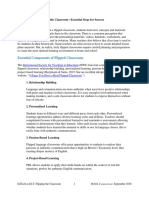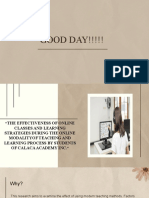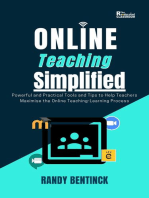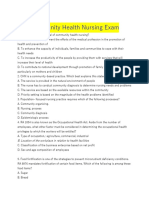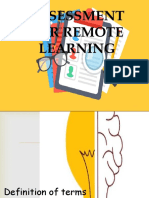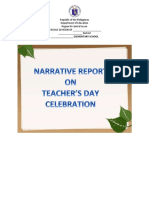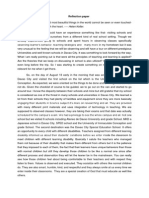0 ratings0% found this document useful (0 votes)
116 viewsBenefits of Remote Learning During This Time of Pandemic
Benefits of Remote Learning During This Time of Pandemic
Uploaded by
Clarisse SampangRemote learning during the pandemic has provided several benefits:
1) It has helped students develop empathy by experiencing challenges together and understanding others' perspectives.
2) Students have identified and helped solve real-world problems caused by the pandemic.
3) It has created greater connection between home and school by requiring more family involvement in students' learning.
Remote learning is shifting education to rely more on digital tools and developing students' 21st century skills like collaboration and problem solving. It is preparing both educators and students for future technological changes.
Copyright:
© All Rights Reserved
Available Formats
Download as PDF, TXT or read online from Scribd
Benefits of Remote Learning During This Time of Pandemic
Benefits of Remote Learning During This Time of Pandemic
Uploaded by
Clarisse Sampang0 ratings0% found this document useful (0 votes)
116 views10 pagesRemote learning during the pandemic has provided several benefits:
1) It has helped students develop empathy by experiencing challenges together and understanding others' perspectives.
2) Students have identified and helped solve real-world problems caused by the pandemic.
3) It has created greater connection between home and school by requiring more family involvement in students' learning.
Remote learning is shifting education to rely more on digital tools and developing students' 21st century skills like collaboration and problem solving. It is preparing both educators and students for future technological changes.
Original Description:
Benefits of Distance Learning during Pandemic
Copyright
© © All Rights Reserved
Available Formats
PDF, TXT or read online from Scribd
Share this document
Did you find this document useful?
Is this content inappropriate?
Remote learning during the pandemic has provided several benefits:
1) It has helped students develop empathy by experiencing challenges together and understanding others' perspectives.
2) Students have identified and helped solve real-world problems caused by the pandemic.
3) It has created greater connection between home and school by requiring more family involvement in students' learning.
Remote learning is shifting education to rely more on digital tools and developing students' 21st century skills like collaboration and problem solving. It is preparing both educators and students for future technological changes.
Copyright:
© All Rights Reserved
Available Formats
Download as PDF, TXT or read online from Scribd
Download as pdf or txt
0 ratings0% found this document useful (0 votes)
116 views10 pagesBenefits of Remote Learning During This Time of Pandemic
Benefits of Remote Learning During This Time of Pandemic
Uploaded by
Clarisse SampangRemote learning during the pandemic has provided several benefits:
1) It has helped students develop empathy by experiencing challenges together and understanding others' perspectives.
2) Students have identified and helped solve real-world problems caused by the pandemic.
3) It has created greater connection between home and school by requiring more family involvement in students' learning.
Remote learning is shifting education to rely more on digital tools and developing students' 21st century skills like collaboration and problem solving. It is preparing both educators and students for future technological changes.
Copyright:
© All Rights Reserved
Available Formats
Download as PDF, TXT or read online from Scribd
Download as pdf or txt
You are on page 1of 10
BENEFITS OF REMOTE
LEARNING DURING THIS
TIME OF PANDEMIC
1. HELPING STUDENTS DEVELOP
EMPATHY FOR OTHERS
• There’s nothing like a pandemic to make us
feel like we are all in the same boat. This has
provided a unique opportunity for students
to understand how others are experiencing
a situation that they themselves are living
through. Many teachers have used this as
great starting point for using design thinking
to understand the needs of others.
2. STUDENTS IDENTIFYING AND
SOLVING REAL-WORLD PROBLEMS
• In an ideal world learning should always be
connected to students own lives and be
based on authentic contexts and
experiences. Teachers have grasped the
opportunity for students to tackle some of
the many real-world problems presented by
the pandemic.
3. GREATER CONNECTION BETWEEN
HOME AND SCHOOL
• We’ve always known that learning is most effective
when there is a partnership between school and
home. Remote learning models have created a
need for families to be actively involved in their
children’s learning. Of course this has been
challenging for busy parents juggling multiple
demands, but it’s also seen many parents
becoming more involved in and aware of their
children’s learning.
4. SHIFT TO DIGITAL TECHNOLOGY
• Digital technologies have been part of learning in
classrooms for a long time now but the shift to
remote learning has seen teachers relying on them
more than ever to provide quality learning
experiences. Many teachers have developed their
capacity for embedding technology in their
teaching and found innovative ways to maximise the
potential of digital tools. Remote learning is shifting
digital tools from a ‘nice to have’ to a ‘must have’.
5. STUDENTS DEVELOPING 21ST
CENTURY SKILLS
• Remote learning models are giving students a
unique opportunity and purpose for developing and
applying many important 21st century skills.
Students are learning new ways to collaborate and
communicate as they interact with their classmates
and educators in new ways. They are also
increasingly being asked to think critically and
creative and solve problems as they find new ways
of accessing and demonstrating their learning.
USEFUL TO DEVELOP FUTURE SKILLS
• In this new age, technology has been changing the
way we work and live. If you want to plan for future
challenges, so the implementation of the new
technology is important. Both educators and
students are seeking to embrace the new technical
methods and applications with the rising use of
technology in the educational vertical
AFFORDABILITY
• Reduced fee structures are another advantage of
professional learning and online learning. In
contrast with physical schooling, online schooling is
much more accessible. This is because online
schooling reduces the cost of accommodation for
students, food for students, and most notably, real
estate.
• The online learning system can be customised in
several ways, with its variety of choices and tools. It
is the only way to build a perfect learning
atmosphere that is suitable for each student’s
needs.
FLEXIBILITY
• Online curriculum encourages the teacher and the
student to set their own rate of learning, and there is
the extra versatility of setting a timetable that suits
the agenda of all. As a result, it makes for a greater
balancing between jobs and studies by having an
online education tool, so there is no reason to give
up something. Studying online teaches you vital
skills in time management, which makes it easier to
find a good work-study balance.
It allows for a customized learning experience.
EFFICIENCY
• Online learning is an easy means for
teachers to offer lessons to pupils. There are
a range of resources for online learning,
such as videos, PDFs, interviews, so all these
options can be used by teachers as part of
their teaching materials. Teachers are willing
to become more effective learners by
expanding the lesson plan beyond
conventional textbooks to incorporate
educational content.
You might also like
- Relevance and Appropriateness in The Use of Technology in Teaching and LearningDocument12 pagesRelevance and Appropriateness in The Use of Technology in Teaching and LearningJeramel Teofilo Manalo88% (8)
- 3 5 Year Old Pre Lesson PlanDocument2 pages3 5 Year Old Pre Lesson Planapi-234949588No ratings yet
- Fourc's 21st CenturyDocument5 pagesFourc's 21st CenturyZeus OngNo ratings yet
- Sec2 FT232040 KetanDocument4 pagesSec2 FT232040 KetanKanika SubbaNo ratings yet
- Current Trends and Issues in EducationDocument24 pagesCurrent Trends and Issues in EducationJocelyn Sumili100% (1)
- Teachers and TeachingDocument14 pagesTeachers and TeachingKarl SiganayNo ratings yet
- ReflectionDocument5 pagesReflectionJessiah Jade LeyvaNo ratings yet
- A Case For Blended LearningDocument14 pagesA Case For Blended LearningDPSG DEHRADUNNo ratings yet
- Smart Class TeachingDocument14 pagesSmart Class Teachinganon_692632828No ratings yet
- Curso Blended Learning1Document24 pagesCurso Blended Learning1Patricia Lizette González PérezNo ratings yet
- GroupDocument20 pagesGroupTashika LewisNo ratings yet
- Blendedlearning 160328130851 PDFDocument31 pagesBlendedlearning 160328130851 PDFMysweet PenNo ratings yet
- Blendedlearning 160328130851Document31 pagesBlendedlearning 160328130851Humberto RussoNo ratings yet
- EAD 523 - Professional Development Optimization of E.L.a. TeachingDocument14 pagesEAD 523 - Professional Development Optimization of E.L.a. Teachingshirley moligaNo ratings yet
- 21 Century Skills: The Challenges Ahead: Andrew J. Rotherham and Daniel WillinghamDocument59 pages21 Century Skills: The Challenges Ahead: Andrew J. Rotherham and Daniel WillinghamJeffrey C. ManiquizNo ratings yet
- 4 CURRENT AND FUTURE TRENDS ToquibDocument8 pages4 CURRENT AND FUTURE TRENDS ToquibJuicy SaniatanNo ratings yet
- Study Tips NewsletterDocument26 pagesStudy Tips Newsletterphucbui2008ptNo ratings yet
- Blended LearningDocument24 pagesBlended LearningJevy Rose Molino MayonteNo ratings yet
- The 21ST Century TeacherDocument16 pagesThe 21ST Century TeacherDan BingelNo ratings yet
- Blended & Reflective LearningDocument11 pagesBlended & Reflective LearningmarideloritNo ratings yet
- Collaboration in Blended Learning Focus in The New Normal EducationDocument13 pagesCollaboration in Blended Learning Focus in The New Normal EducationAnn Louise De LeonNo ratings yet
- The Importance of Adaptability Among TeachersDocument4 pagesThe Importance of Adaptability Among TeachersNora HerreraNo ratings yet
- Distance Learning Essentials 1Document25 pagesDistance Learning Essentials 1api-668405692No ratings yet
- Flipping The ClassroomDocument4 pagesFlipping The ClassroomLesyaNo ratings yet
- Webinar PresentationDocument20 pagesWebinar PresentationKimberly CardenasNo ratings yet
- Faculty of Education and Languages: Assignment Title: Challenges in Blended LearningDocument18 pagesFaculty of Education and Languages: Assignment Title: Challenges in Blended LearningjanetfaustinaNo ratings yet
- Technology in Education Technology PresentationDocument15 pagesTechnology in Education Technology PresentationBien Joshua Martinez PamintuanNo ratings yet
- Using Blended Learning To Accommodate Different Learning StylesDocument5 pagesUsing Blended Learning To Accommodate Different Learning StylesAndy PierceNo ratings yet
- Lesson 07 - Beetc 680Document6 pagesLesson 07 - Beetc 680ayeshastudies888No ratings yet
- Name: Year: Subject: Assessment Ii Date: Instructor/Professor: MR. ROMEO REDULLADocument3 pagesName: Year: Subject: Assessment Ii Date: Instructor/Professor: MR. ROMEO REDULLANormina CagunanNo ratings yet
- What Is Remote LearningDocument8 pagesWhat Is Remote LearningKevin LOZANO RAMIREZNo ratings yet
- Flipped ClassroomDocument6 pagesFlipped Classroomkim palabayNo ratings yet
- PatrickDocument14 pagesPatrickSantino AdmanaNo ratings yet
- Online Teachng StrategiesDocument2 pagesOnline Teachng Strategiesrex.egonio.jrNo ratings yet
- Unlock Your Child's Genius - The Secret Weapon of Online TutoringFrom EverandUnlock Your Child's Genius - The Secret Weapon of Online TutoringNo ratings yet
- THE CONCEPT OF SMART CLASSROOM - Dr. V.K. Maheshwari, PH.D PDFDocument15 pagesTHE CONCEPT OF SMART CLASSROOM - Dr. V.K. Maheshwari, PH.D PDFumi yuni100% (1)
- Effective TeachingDocument21 pagesEffective TeachingSadaa PandoyiNo ratings yet
- Communication Aids and Strategies Using Tool of Technology: Mam SalveDocument19 pagesCommunication Aids and Strategies Using Tool of Technology: Mam SalveRonizza ElardoNo ratings yet
- FinalOutput QUIPPERDocument15 pagesFinalOutput QUIPPERMaia Jonah Angela TulbaNo ratings yet
- Digital LearningDocument2 pagesDigital LearningAtiya FalakNo ratings yet
- Effective Teaching MethologyDocument4 pagesEffective Teaching Methologyrobertson_izeNo ratings yet
- Act ResearchDocument7 pagesAct ResearchCyrel MercadoNo ratings yet
- Unit 1. Define Terms and Concepts Related To Technology in EducationDocument91 pagesUnit 1. Define Terms and Concepts Related To Technology in EducationLihle MaqandaNo ratings yet
- Blended Learning: Assignment 1: Emerging Trends in E-LearningDocument2 pagesBlended Learning: Assignment 1: Emerging Trends in E-LearningNihalNo ratings yet
- MaterialsDocument6 pagesMaterialspaul andres brito delgadoNo ratings yet
- Covid Book ToolkitDocument52 pagesCovid Book ToolkitvibhaNo ratings yet
- Flipped Classroom BriefDocument4 pagesFlipped Classroom BrieffdzgeosNo ratings yet
- Teaching Profession - Assignment1 - Realyn TDocument5 pagesTeaching Profession - Assignment1 - Realyn TEya Delos Santos TañecaNo ratings yet
- Notes #4Document3 pagesNotes #4jolaiNo ratings yet
- 9 Unique Ways To Use Technology in The ClassroomDocument6 pages9 Unique Ways To Use Technology in The ClassroomAngel PendonNo ratings yet
- The Basics of K-12 Asynchronous Learning: Definition, Benefits, and ActivitiesDocument5 pagesThe Basics of K-12 Asynchronous Learning: Definition, Benefits, and ActivitiesERWIN MORGIANo ratings yet
- Characteristics of A Classroom ManagementDocument15 pagesCharacteristics of A Classroom Managementくろせいじん60% (5)
- Implications To Teaching and LearningDocument20 pagesImplications To Teaching and LearningCrestilen GualingcoNo ratings yet
- Introduction To Online Teaching and Learning Joshua Stern, PH.DDocument10 pagesIntroduction To Online Teaching and Learning Joshua Stern, PH.DYengchien WongNo ratings yet
- Nature and Scope of Distance EducationDocument7 pagesNature and Scope of Distance EducationhabibshanglaNo ratings yet
- Group 4 Quiz Prof Ed 7Document2 pagesGroup 4 Quiz Prof Ed 7Marissa CultivoNo ratings yet
- W 6 - Media Trends in The Educational SystemDocument40 pagesW 6 - Media Trends in The Educational SystemSaltanat KuramshinaNo ratings yet
- Computer Assignment #1 Aiqan 5-BlueDocument4 pagesComputer Assignment #1 Aiqan 5-Blueaiqan bin adeelNo ratings yet
- Caro, Lauria Ella - 3-16 - Assign 3Document2 pagesCaro, Lauria Ella - 3-16 - Assign 3LAURIA ELLA CARONo ratings yet
- Innovative Ideas That Transform SchoolsFrom EverandInnovative Ideas That Transform SchoolsRating: 5 out of 5 stars5/5 (1)
- Community Health Nursing ExamDocument24 pagesCommunity Health Nursing ExamClarisse SampangNo ratings yet
- How To Solve Number Series Problems - Number Series and PatternDocument6 pagesHow To Solve Number Series Problems - Number Series and PatternClarisse SampangNo ratings yet
- Assessment For Remote LearningDocument27 pagesAssessment For Remote LearningClarisse SampangNo ratings yet
- Scout Oath and LawDocument9 pagesScout Oath and LawClarisse SampangNo ratings yet
- Narrative Report On Teacher's Day CelebrationDocument5 pagesNarrative Report On Teacher's Day CelebrationClarisse SampangNo ratings yet
- Factors Affecting Gender Equality in EducationDocument17 pagesFactors Affecting Gender Equality in EducationClarisse Sampang100% (1)
- FACTORS AFFECTING THE ACADEMIC PERFORMANCE PPT PresentationDocument37 pagesFACTORS AFFECTING THE ACADEMIC PERFORMANCE PPT PresentationMarites Espino MaonNo ratings yet
- Standard 6 RDocument1 pageStandard 6 Rapi-245260210No ratings yet
- JH ResumeDocument1 pageJH Resumeapi-353470034No ratings yet
- DLP ART6 Q-2 August 28, 2019 (Week3)Document3 pagesDLP ART6 Q-2 August 28, 2019 (Week3)Ronnie SumicadNo ratings yet
- Module 1: Adapting College Life in PHILSCADocument2 pagesModule 1: Adapting College Life in PHILSCAAngelo IbañezNo ratings yet
- Brigada Eskwela Narrative 2018Document11 pagesBrigada Eskwela Narrative 2018Kathy Damaulao100% (1)
- Lesson Plan Teacher: Dana Pablo, Melynda San Luis, Jenny Maluwelmeng, Vaughn Baisa Grade Level: 3 GradeDocument2 pagesLesson Plan Teacher: Dana Pablo, Melynda San Luis, Jenny Maluwelmeng, Vaughn Baisa Grade Level: 3 Gradeapi-287241324No ratings yet
- Reflection PaperDocument2 pagesReflection Paperapi-266964146No ratings yet
- Lynnuel Joshua Austria - LE-3Document4 pagesLynnuel Joshua Austria - LE-3Maj FernandezNo ratings yet
- Elt Module 2 Unit 6 W4Document4 pagesElt Module 2 Unit 6 W4LineClar RealNo ratings yet
- Comprehension Reading LessonDocument3 pagesComprehension Reading Lessonapi-248716727No ratings yet
- Daily Lesson Log: En9Wc-Ivc-11: En9G-Ivi-25: En9Lt-Ivc-17Document4 pagesDaily Lesson Log: En9Wc-Ivc-11: En9G-Ivi-25: En9Lt-Ivc-17MarissaM.PerezNo ratings yet
- Interface of Curriculum and Teaching Activities: Group 2 Aminah Mega Melia Riri Algafar Yozi Ananda PutriDocument13 pagesInterface of Curriculum and Teaching Activities: Group 2 Aminah Mega Melia Riri Algafar Yozi Ananda PutriAminah RosaNo ratings yet
- Lesson Plan - I Got RhythmDocument4 pagesLesson Plan - I Got Rhythmapi-551123180No ratings yet
- Practicum LPDocument8 pagesPracticum LPShah Rul MalikNo ratings yet
- RPH Super Mind Y1 L1 2019Document3 pagesRPH Super Mind Y1 L1 2019AnbaRasi KrishNanNo ratings yet
- W1-D1 Lesson Plan Science 7-MatatagDocument3 pagesW1-D1 Lesson Plan Science 7-MatatagCristy Galagar100% (10)
- Rebecca Wilman 17325509 Educ4020 Assessment 2Document5 pagesRebecca Wilman 17325509 Educ4020 Assessment 2api-314401095No ratings yet
- Student Assessment ProjectDocument9 pagesStudent Assessment Projectapi-461948489No ratings yet
- Cls 3 Plan LectieDocument3 pagesCls 3 Plan Lectiebalea codrutaNo ratings yet
- Educator Effectiveness System - Differentiated Supervision Kel 11Document3 pagesEducator Effectiveness System - Differentiated Supervision Kel 11Anita ShopNo ratings yet
- Minggu Yang Ke: 2 HARI: Sunday TARIKH: 8/1/17: Rancangan Pengajaran Dan Pembelajaran HarianDocument1 pageMinggu Yang Ke: 2 HARI: Sunday TARIKH: 8/1/17: Rancangan Pengajaran Dan Pembelajaran HarianYusnita YusofNo ratings yet
- Inset Proposal 2019Document6 pagesInset Proposal 2019Route87 Internet Cafe50% (2)
- Unit 3 Superheroes WritingDocument7 pagesUnit 3 Superheroes WritingZahidah Husna Zulkifli100% (1)
- Sample Letter For 2013 Conference PDFDocument1 pageSample Letter For 2013 Conference PDFBersabe T. TrajeNo ratings yet
- Martha Naranjo ResumeDocument3 pagesMartha Naranjo Resumeapi-524058157No ratings yet
- Final Theme - Learning Engagement - How We Organize Ourselves - Pyp-2Document7 pagesFinal Theme - Learning Engagement - How We Organize Ourselves - Pyp-2sadafNo ratings yet
- June 2011 Paper 2 Updated PDFDocument8 pagesJune 2011 Paper 2 Updated PDFMarcio OliveiraNo ratings yet
- Detailed Lesson Plan (DLP)Document2 pagesDetailed Lesson Plan (DLP)Catherine VillaruzNo ratings yet























